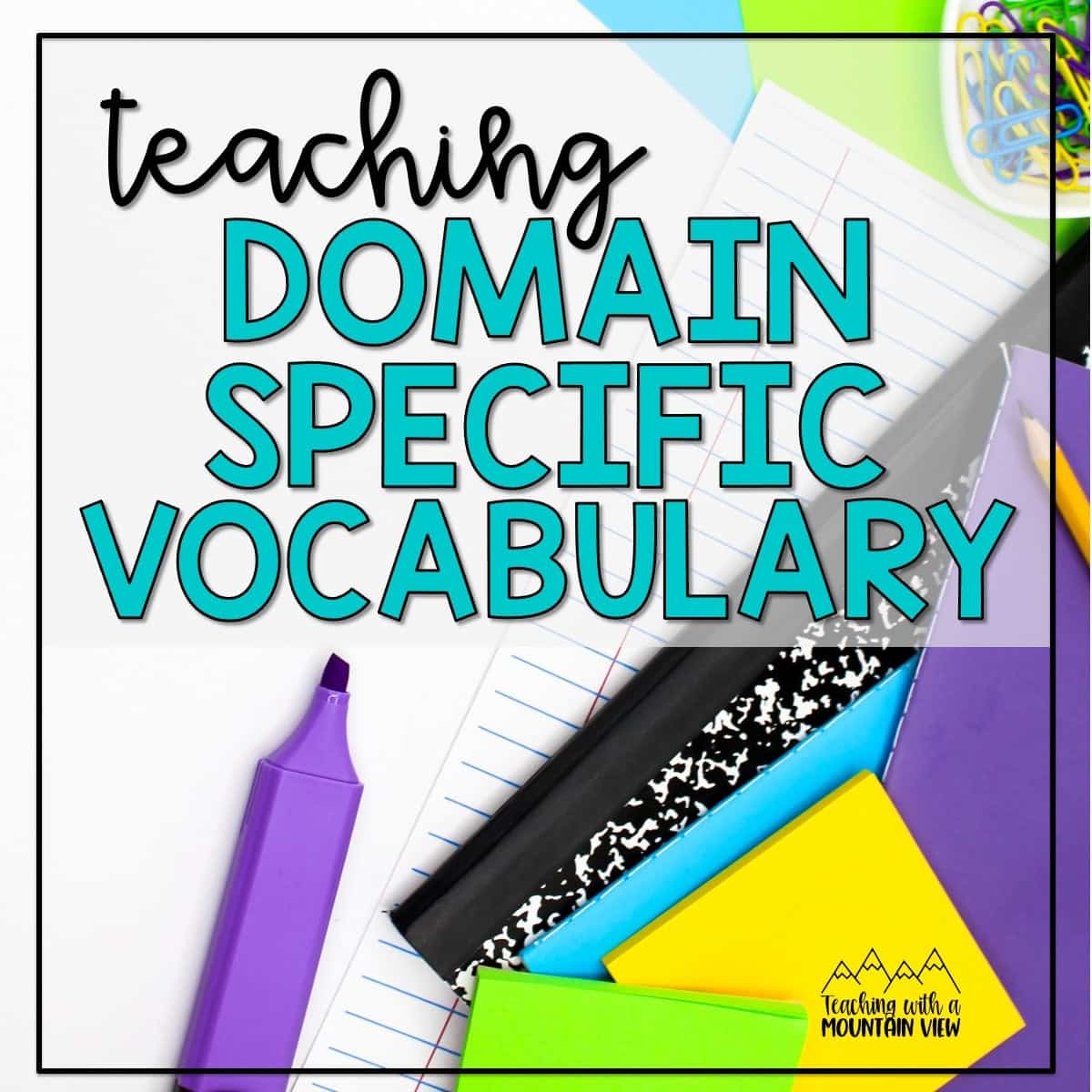
Today we’re chatting about the importance of explicitly teaching domain specific vocabulary. This standard calls for students to be able to determine the meaning of general academic and domain-specific words and phrases in a grade-level text, and whether you follow Common Core Standards, state standards, or live somewhere else around the world, this plan of attack for teaching vocabulary will be relevant for you, too. We’re going to really focus in on domain specific vocabulary today and how to infuse that into your unit plans and instruction.
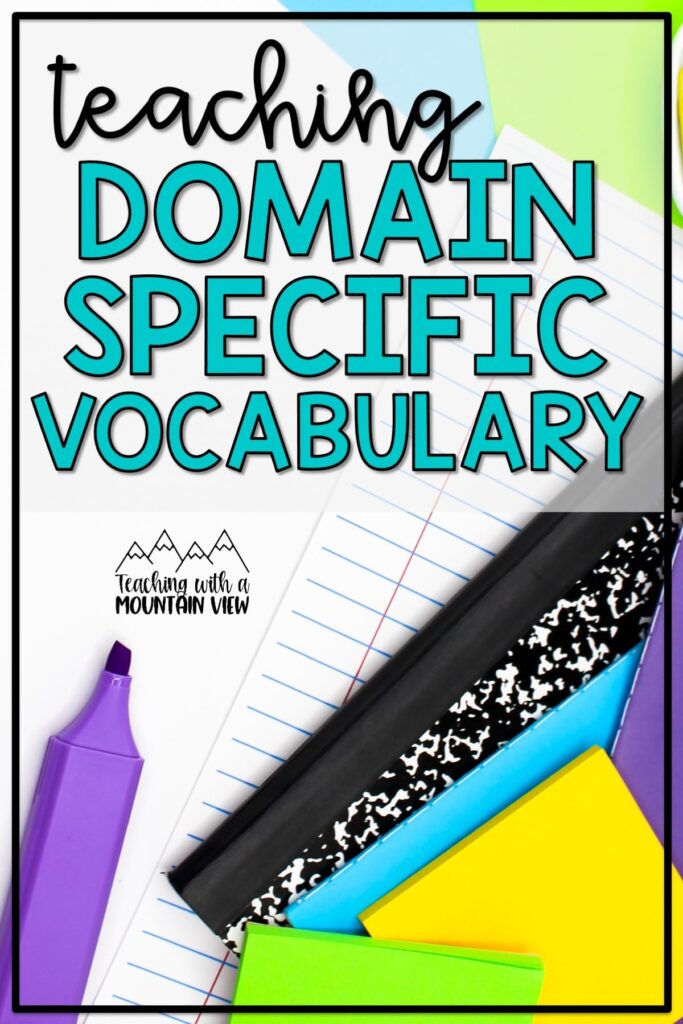
Vocabulary instruction may or may not come naturally to you as a part of your literacy instruction, but is it front of mind as you’re planning instruction outside of literacy? We’re going to chat about the importance of explicitly teaching domain specific vocabulary outside of the literacy classroom (and inside of, a little bit) and how I approach this instruction in a very sequential way.
What is domain specific vocabulary?
Domain specific vocabulary refers to vocabulary terms that are specific to a topic of study. This is our precise, content-related vocabulary that is infused throughout our units. These may be the words that are on our word walls and show up in glossaries of our math, science, and social studies textbooks.
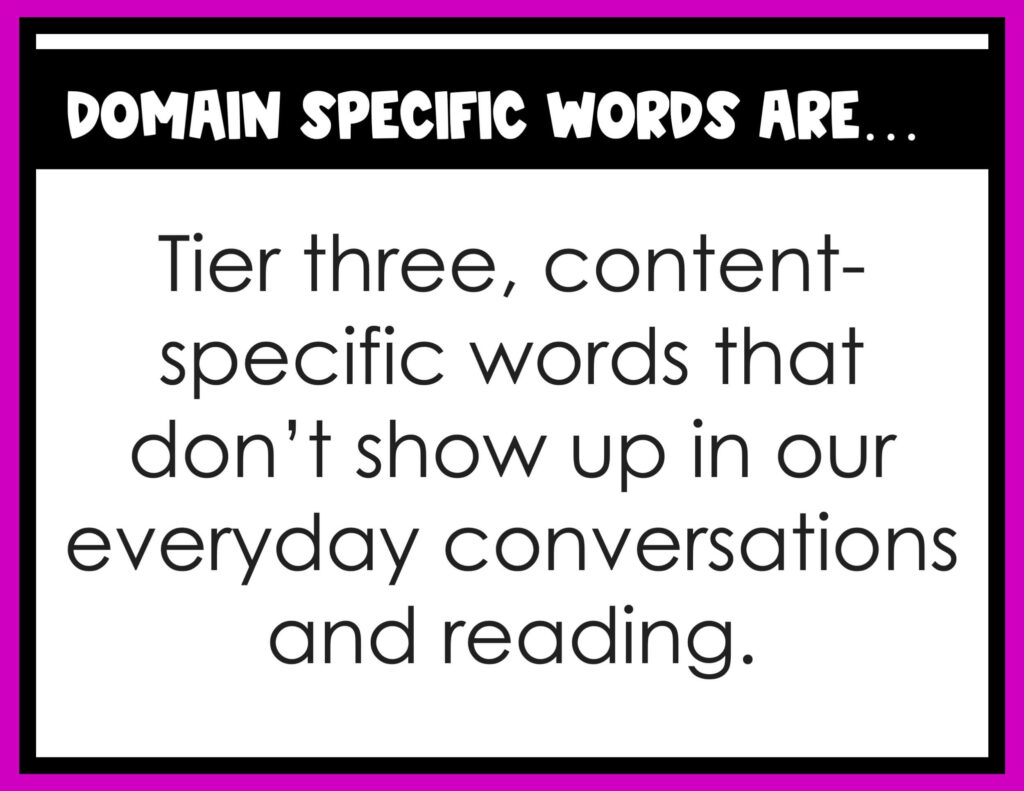
When thinking about the three tiers of vocabulary words, domain-specific words fall into the tier 3 category of words… the words that are not a part of our normal vocabulary, unless we are engaged in a conversation or study about a particular topic.
In science, domain specific words might include things like photosynthesis, hibernation, nocturnal, classification, species, hypothesis, etc.
In math, domain specific vocabulary refers to very precise math vocabulary terms like equivalent, quotient, product, etc.
Word walls are wonderful, students absolutely must know how to use a dictionary to look up the meaning of unknown words, and I’m a gigantic fan of using interactive notebooks to keep notes about specific vocabulary terms, but when we get into the nitty gritty of domain-specific words, I follow a plan of introduction that enables students to naturally interact with the words in a way that encourages mastery and understanding and also in a way that prepares them to attack these words in the future without your direct instruction.
The research behind it…
Research shows that it can take up to 17 exposures for children to put a new word into their long term memory. We have so many strategies at the ready to teach students new words, but we have to remember: repeat, review, retrieve, repeat, review, retrieve, repeat, review, retrieve. The more students are exposed to these words authentically, the better understanding they will truly have of the word.
Where do I find these vocabulary words?
I highly encourage you to start with your units of study to find your domain-specific vocabulary. The point here isn’t necessarily to master a specific list for each grade level, but to master the words that are authentically showing up in YOUR units of study and to become comfortable working with big, meaning-filled words in context. Any time I am planning out a unit, I always make a list of important vocabulary words as I plan the content.
How I specifically and intentionally incorporate domain-specific vocabulary into my units of study without my students even really knowing it.
When introducing words, I follow a specific procedure to expose them to these words:
Note that this is a bit of a different approach from the typical “give and receive” where we straight up give students definitions of domain specific words, have them copy them, write them in a sentence, etc. While there is absolutely a time and a place for these things (it shows up in this sequence!), this approach exposes them to the word in a systematic manner to help them develop their own understanding of it so their understanding is not simply a regurgitation of what we’ve told them. Our goal is to nurture nightingales or canaries who can write and develop their own “vocabulary song,” not parrots who repeat and regurgitate words and dictionary definitions with no real meaning.
During each of these layers of teaching, be sure you are specifically calling out the words and talking about their meaning each and every time they are exposed to them. While this should seamlessly integrate into your unit (students shouldn’t know you are really honing in on vocabulary at every juncture within this process), it’s important to note that this process is in addition to any other learning engagements you are working on during the given unit, which means they will be further authentically exposed during stations, experiments, etc.
Our ultimate goal here is to encourage students to gain independence in gathering vocabulary knowledge, meaning we want them to tune in to this content-specific vocabulary (instead of just blazing past it like many children will do when confronted with an unknown and daunting word…). We want them to pick out these technical terms and have strategies they can use to approach them.
Will you always be able to follow this sequence as you introduce academic vocabulary? Absolutely not. But the more often you can use at least parts of it, the more it will become second-nature for students to interact with vocabulary words.
Throughout the process, we will use so many modalities: visual, auditory, tactile through writing, etc. that are all proven by research to be essential to vocabulary acquisition.
My Approach to Teaching Vocabulary
Approach and Expose It: Begin with authentic texts (picture books are best here! If you can find a picture book that incorporates your words, that’s key!) and easy-to-watch videos so they can see the words (or most of the words) used in a relatable, approachable scenario. Incorporating video is especially important because they need to hear the word pronounced correctly by multiple people, multiple times. Bonus points if you can find a video with captions! This goes for all video viewing. I always turn on captions for my students who may not process the auditory quite as well but thrive with reading on the screen (bonus points for extra reading time, too!).
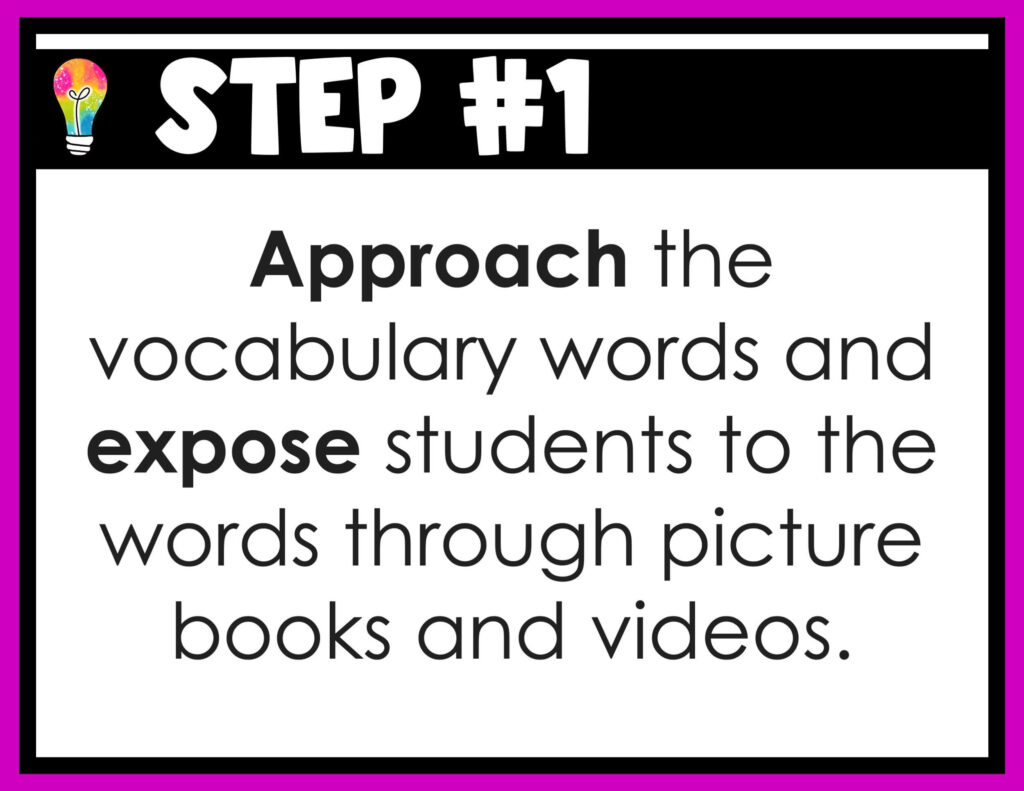
Read It: Now that we’ve approached it and started to expose the vocabulary without that super explicit instruction, it’s time to read it. Move on to more specific nonfiction passages where you move through a close read and use context clues to dissect the words and their meanings based on text features, context clues, pictures, etc. This is assuming that you’ve already tackled using context clues in the classroom and different ways to use context clues to approach new words. This is a great opportunity to find newspaper articles or texts that have great text features that help add to the vocabulary word’s meaning. This is the point where we are explicitly teaching our students specific strategies to use when they are confronted with unknown words in their technical texts. This is the equivalent of a close read, and I highly recommend this be done in a small group setting with differentiated texts, if possible.
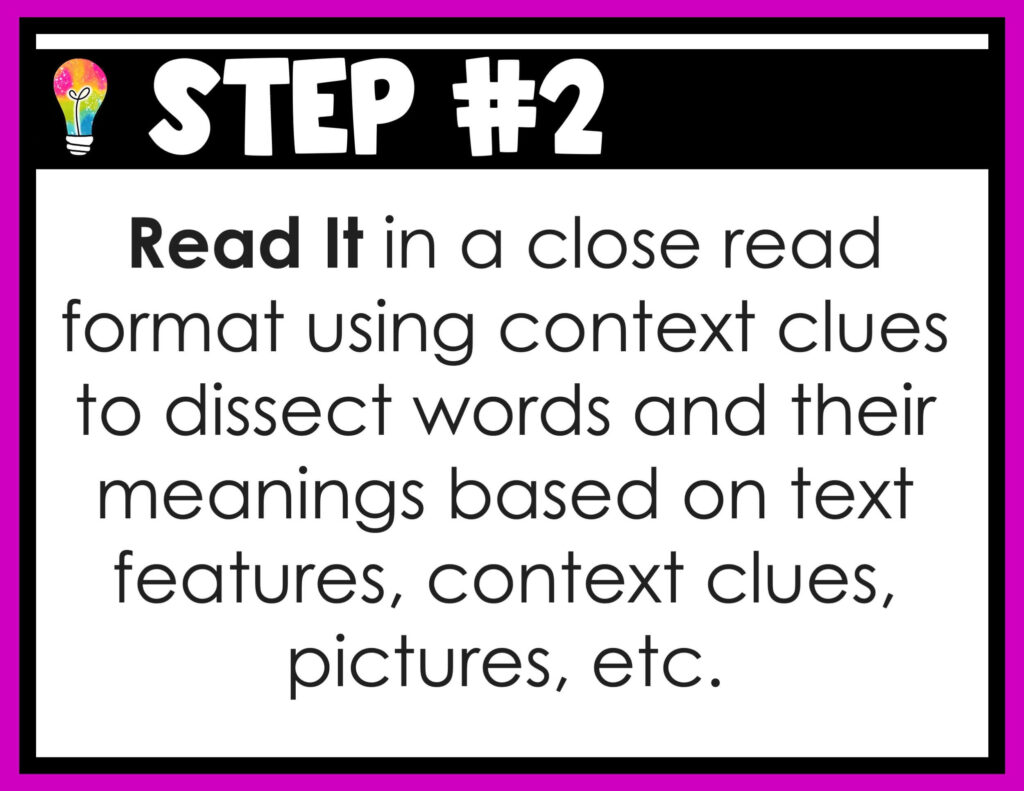
Perform It: At this point, we’ve already been exposed to the words through a video, book, and some sort of close read. Now, it’s time to perform it. Incorporate the words into a student presentation where the content is already made for them. For example, have students participate in a reader’s theatre, a poetry presentation, or drama circle that uses the words so that they can become familiar with not only the meaning of the word but have the opportunity to verbalize it, practice perfecting the pronunciation, correct usage within a sentence, etc. They aren’t having to do a lot of generation of thought here, but they are having to work with the word. This can even be as simple as finding more picture books and doing a quick book talk that uses those specific words. The key is that they aren’t doing a ton of generation of new content here, but they are still working with the words. You even get some bonus points here if you are having students perform it in front of the rest of the class, which further exposes the rest of the students to the vocabulary terms again and again.
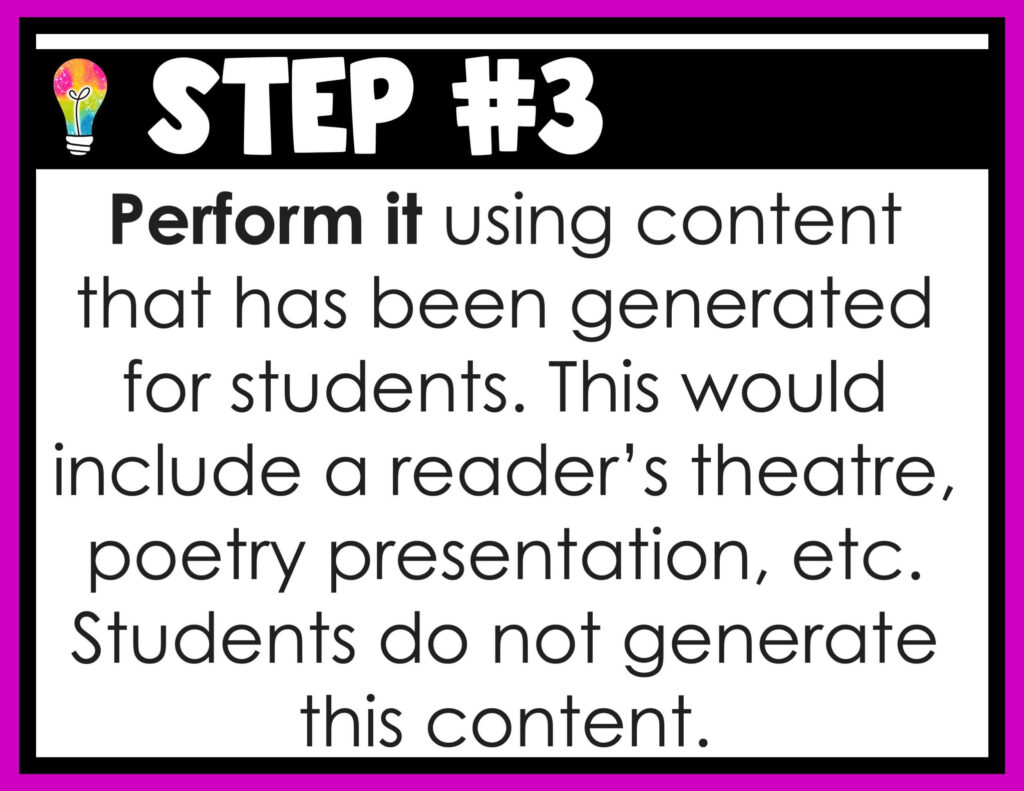
Note It: This is the part that we typically think about when we consider incorporating vocabulary into our study, and if you prefer to move this up before students perform, that’s perfect, too. I like to do this portion after a performance because it gives students the opportunity to generate their own definition, and then we can refine it together here.
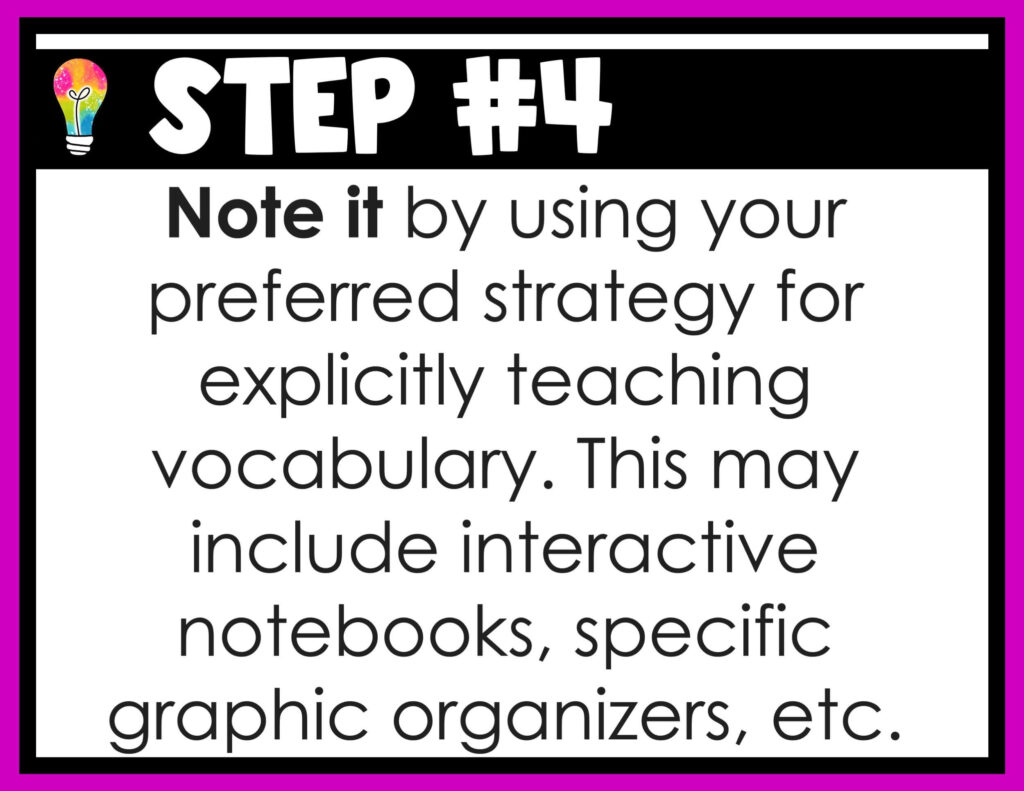
By this point, they will have had multiple exposures to the word and opportunities to dissect the word. This is when you will really take and dissect the word parts (affixes and roots), talk about different meanings, tenses, and variations, how it relates to your content, your life etc. This is a great time to use non-examples of the words, talk about synonyms and antonyms, etc. This is your VERY SPECIFIC vocabulary study portion of your unit. For example, this is a great time to point out that there are words that we use in math that are used all the time outside of math, literacy, science, etc. Be sure to have all of the content from the first three steps at the ready to use as notes.
A quick aside about word parts
This is the perfect time to incorporate word parts. While it may or may not be part of your vocabulary instruction normally, this is an ideal time to integrate prefixes, suffixes, and roots (which are also domain-specific words!) seamlessly into your instruction. Any time I have the opportunity to point out word parts, I do!
For Example: When I’m teaching about division, and I’m teaching remainders, I ALWAYS point out that “remain” is part of the word.
If you’re teaching about habitats, you can throw in
Aquatic (aqua)
Domestic (domicile means home, and so does domestic)
This is the time where students…
- Take notes in interactive notebooks with definitions, examples, and pictures of the words.
- I’m including two options for graphic organizers that you can use with your students. There are interactive notebooks here as well as a specific word study page that you can use to dive deeply into specific words.
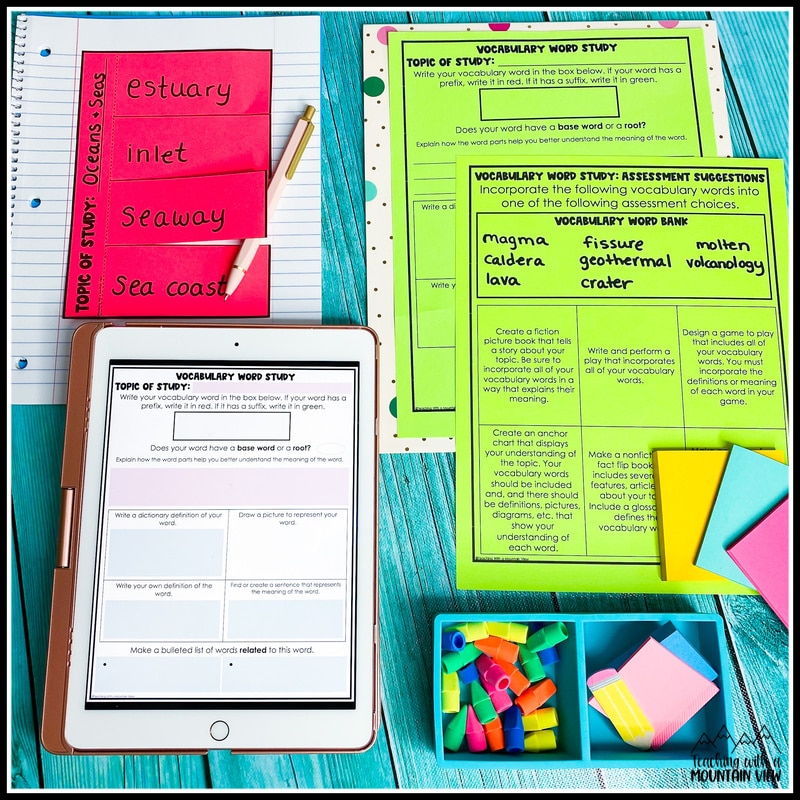
- This is a great time to incorporate graphic organizers like the Frayer Model, where students look at specific definitions, characteristics, examples, and non examples.
- Semantic maps or mind maps are another way to take notes about your vocabulary words, and kids LOVE this! You place your give word in the middle and create a map or web to show the meanings and connections. I totally recommend doing one of these during unit studies and eventually finding a way to tie ALL of your vocabulary words into map.
- Use Cloze context clues, activities here or even nonsense words in place of the vocabulary words for students to practice selecting the appropriate words.
- Apply It: Students complete a performance-based task that incorporates the words. This is the opposite of the “Perform it” section, where they really weren’t generating any content. This time they are doing ALL the generation. This can come in the form of a presentation, research project, creating a game, writing their own picture book about the topic, etc. Anything that you can use that they are showing you an understanding of the word. This can be your cumulative assessment about the topic as a whole, and it tends to be so much more authentic to gauge understanding than a pencil/paper vocabulary test. I’ve included several options for you to use as cumulative activities for ANY unit that incorporate your domain-specific vocabulary words.
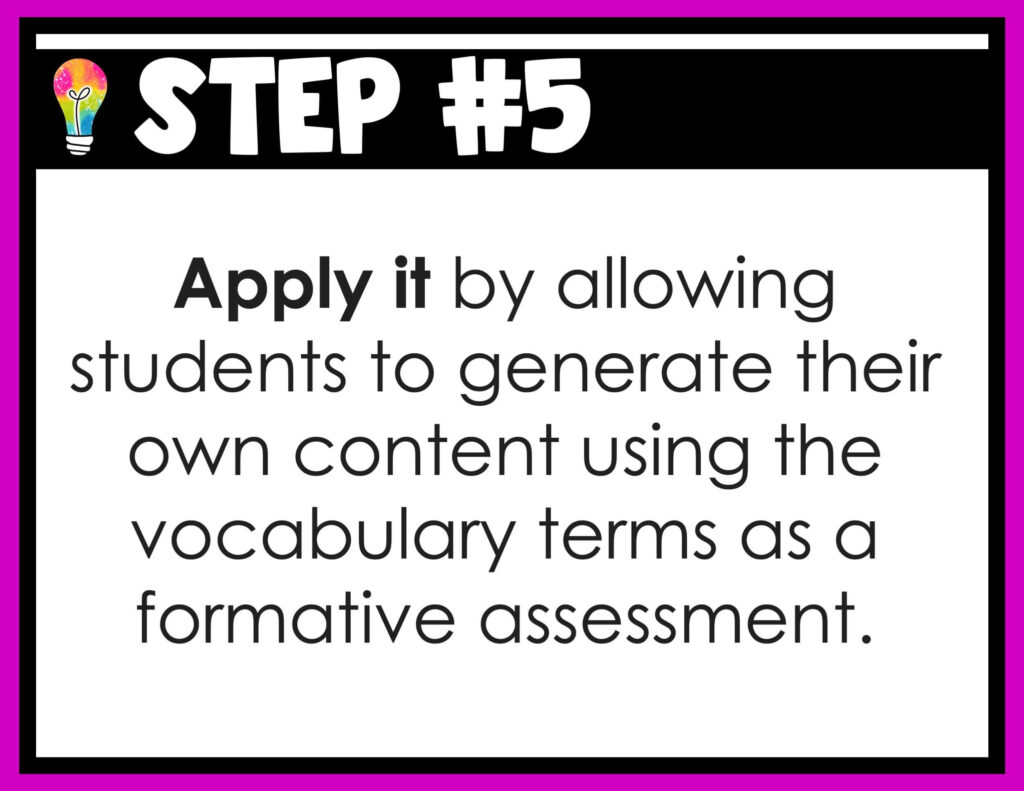
- Recall and retrieve: Make sure you are giving ample opportunities to use retrieval practice and recall the words and their meanings WITHOUT anything in front of them.
Bottom line: Exposure is critical, but so is direct instruction so that they can transfer these skills to any of their reading.
FREE Vocabulary Templates
Remember that the main goal here is not only to master the domain-specific vocabulary you are currently working on, but to equip students to approach these words and general vocabulary words at any time.
I hope this leaves you feeling well-equipped to begin tackling this tricky, but oh, so important vocabulary skill and that you are leaving with a plan for approaching it in the future.
Mary Montero
I’m so glad you are here. I’m a current gifted and talented teacher in a small town in Colorado, and I’ve been in education since 2009. My passion (other than my family and cookies) is for making teachers’ lives easier and classrooms more engaging.











